 Website:
ASTURIANA DE LAMINADOS
Website:
ASTURIANA DE LAMINADOS
Catalog excerpts

Roofing systems overview Double lock standing seam
Open the catalog to page 1
Roofing systems overview – Double lock standing seam | 3 Sistemas de revestimiento - Junta alzada para fachadas Index Main characteristics Principal joints Cross joints Standing seam tray dimensions Rainwater drainage Roof shapes Substrates and roof construction
Open the catalog to page 3
4 | Roofing systems overview – Double lock standing seam
Open the catalog to page 4
Roofing systems overview – Double lock standing seam | 5 Main characteristics The double lock standing seam system provides a lightweight, sustainable and very durable roofing solution and is commonly used on many different building types including educational, healthcare, sports, comercial, religious and, of course, housing. The system is suitable for roofs pitched between 3º and 90º, barrel vaulted roofs, conical and domed roofs, and in general almost any type of roof that can be clad in elZinc ®. This is a proven traditional system that has been used to install zinc since the origins of...
Open the catalog to page 5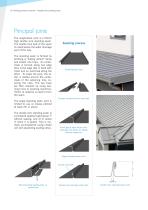
6 | Roofing systems overview – Double lock standing seam Principal joints The longitudinal joint is a 25mm high double lock standing seam. The double lock welt of the seam is raised above the water drainage part of the tray. The standing seam is formed by profiling or folding elZinc ® strips and sheets into trays. An undercloak is formed along one edge (this is the edge that is fixed with clips) and an overcloak along the other. To make the joint, the latter is welted around the undercloak of the adjoining tray, covering the clips. The two trays are then seamed up using seaming irons or...
Open the catalog to page 6
Roofing systems overview – Double lock standing seam | 7 Cross joints It is sometimes necessary to join standing seam trays end to end. Without going into too much detail in this document, this may be to introduce an expansion joint on ‘long’ roofs (long eaves to ridge measurement), as part of the flashing work around a chimney or skylight, or to produce a change in tray width on a conical roof, for example. Generally speaking, the type of joint used will depend on the pitch of the roof slope, as shown here. Step Pitch: 3 o and above Height: 60mm Often used as an expansion joint on long,...
Open the catalog to page 7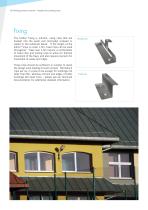
8 | Roofing systems overview – Double lock standing seam Fixing The hidden fixing is indirect, using clips that are hooked into the seam and (normally) screwed or nailed to the substrate below. If the length of the elZinc ® trays is under 1,5m, fixed clips can be used throughout. Trays over 1,5m require a combination of fixed clips and sliding clips to allow for thermal movement of the trays, and also require provision for movement at eaves and ridge. These clips should be sufficient in number to resist the design wind loading for each project. Normally 6 clips per sq. m prove to be enough...
Open the catalog to page 8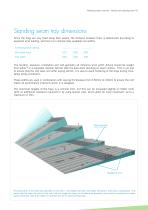
Roofing systems overview – Double lock standing seam | 9 Standing seam tray dimensions Since the trays are only fixed along their seams, the distance between them is determined according to expected wind loading, and tied in to commercially available coil widths. Increasing wind loading Coil width (mm) Tray width The location, exposure, orientation and roof geometry all influence wind uplift. Advice should be sought from elZinc ® or a reputable installer familiar with the area when deciding on seam centres. This is not just to ensure that the roof does not suffer during storms, it is also...
Open the catalog to page 9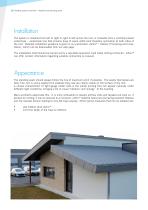
10 | Roofing systems overview – Double lock standing seam Installation The system is installed from left to right or right to left across the roof, or outwards from a centrally placed undercloak – undercloak tray that ensures trays of equal width (and therefore symmetry) at both sides of the roof. Detailed installation guidance is given in our publication ‘elZinc ® – Details, Processing and Installation’, which can be downloaded from our web page. The installation itself should be carried out by a reputable specialist, hard metal roofing contractor. elZinc ® can offer contact information...
Open the catalog to page 10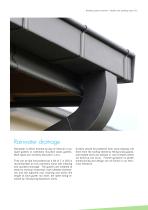
Roofing systems overview – Double lock standing seam | 11 Rainwater drainage Rainwater is either drained by way of internal or parapet gutters or externally mounted eaves gutters. Both types are normally executed in zinc. They can be laid horizontally but a fall of 1 in 200 is recommended as this promotes some self-cleaning and quickens drainage. The gutters are installed to allow for thermal movement, both between themselves and the adjacent roof covering and within the length of each gutter run itself, the latter being resolved by introducing expansion joints. Gutters should be protected...
Open the catalog to page 11
12 | Roofing systems overview – Double lock standing seam Roof shapes Barrel vaulted roof Standing seam trays will naturally curve to a radius of about 20m. Tighter curves will require pre-curving (possible down to a minimum radius of ≈40cm). Trays are fixed at the apex of the roof on an unvented or cross-vented roof, and next or very near to both sides of the ridge on a ridge-vented roof. Here, the tops of the trays next to the ridge vent should be pitched to allow water to drain away freely - 3o over their first metre is advised. Seams should be sealed in areas of the roof pitched below...
Open the catalog to page 12
Roofing systems overview – Double lock standing seam | 13 Open conical roof The same tray type and fixing method are used here as are with a regular conical roof. If the roof is vented and a running inlet at the bottom is used, the minimum inlet should be checked. The band of fixed clips (omitted in this diagram) is positioned according to roof pitch. These trays will concentrate rainwater which should be borne in mind when designing the gutter to prevent rainwater ‘spouting’ over its front edge. Straight tapered tray Domes The trays normally have to be formed after taking measurements on...
Open the catalog to page 13
14 | Roofing systems overview – Double lock standing seam Substrates and roof construction Standing seam trays are not self-supporting and require a fully or almost fully supporting substrate against which they rest and to which their clips are fixed. The substrate can be vented or unvented but it is essential that the roof build-up is correctly executed in either design to avoid the risk of interstitial condensation that could damage the roof. More guidance on this is given in our technical literature. Wood is used for the substrate on ventilated roofs, in the form of soft-wood boarding,...
Open the catalog to page 14All ASTURIANA DE LAMINADOS catalogs and technical brochures
-
elZinc for facades and roofs
28 Pages
-
Rainwater Drainage System elZinc
46 Pages
-
Honeycomb panel
4 Pages
-
Aesthetic Finishes
6 Pages
-
elZinc in Leed Certification
16 Pages
-
Flat lock shingle for façade
10 Pages
-
Façade panel
11 Pages
-
Angle standing seam Overview
10 Pages











